Protect Yourself
Skin cancer is the most common cancer diagnosis, and it's the most preventable cancer. Most skin cancer is caused by damage from the sun's UV rays (ultraviolet radiation). This year, an estimated 68,000 people will be diagnosed with melanoma, the most dangerous type of skin cancer, and nearly 12,000 will die from this disease. Every year, as many as two million people are diagnosed with non-melanoma skin cancer; either basal cell or squamous cell carcinoma.
Recent research on the benefits of vitamin D (made by the skin from sunlight) indicates that just a brief exposure to your face, arms and hands from the sun is sufficient; about 15 minutes a day, three days per week. Talk to a health-care professional about Vitamin D and your health.
Sunless tanning products are generally regarded as safe alternatives to sunbathing. DHA has been approved by The Food and Drug Administration (FDA) for over 30 years for cosmetic applications, and is considered safe when applied to your skin.
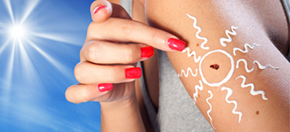
Those At Risk
- People who spend time in the sun or use sun lamps or tanning booths
- People who smoke
- People who have blond, red or light-brown hair and blue, gray or green eyes
- People with fair skin or freckles or skin that burns easily
- People with personal or family histories of skin cancer
- People with certain types of genetic problems that affect the skin
- People who have been treated with radiation
- People with weakened immune systems
- People who have several moles on their bodies; especially those whom have had moles since birth
- People who have oddly-shaped moles or one or more large, colored spots on their skin
- People who have had contact with certain chemicals, such as arsenic in drinking water
- People with damaged skin from injury or from long-term inflammation
- People with HPV (human papillomavirus)
Men are more likely than women to get non-melanoma skin cancer. Caucasians are more likely to develop melanoma than African Americans. However, anyone may develop skin cancer. The risk for skin cancer increases as people age.
Risk Reduction and Early Detection
- Avoid the sun, especially between 10am and 4pm, and don't use sun lamps or tanning beds.
- Always use sunscreen and lip balm with UVB and UVA protection with SPF 30 or more - even on cloudy days.
- Apply an ounce of sunscreen, a palm full, 20 minutes before going in the sun and reapply every two hours if in continuous sun exposure.
- Wear sunglasses that have been treated to absorb UV radiation, a wide-brim hat and clothing made of tightly woven material with long sleeves.
- Protect children from the sun. Childhood sunburns may increase the risk of melanoma later in life.
- Look at your skin once a month. Tell your health care professional about any changes.
- Have your health care professional examine your skin once a year after age 50.
Symptoms
- A sore that doesn't heal.
- A mole or other growth you haven't noticed before.
- Change in the border of a spot, spread of color, redness or swelling around the area.
- A small, smooth, shiny, pale or waxy lump that may bleed.
- Large areas with oozing or crust.
- A flat red spot or a lump that is scaly or crusty.
- Itchiness, tenderness or pain from a mole on your skin.
- A brown or black colored spot with uneven edges.
- Asymmetry (one-half of the mole doesn't match the other).
- Border irregularity.
- Color that is not uniform.
- Diameter greater than 6 mm (about the size of a pencil eraser).
- Evolving size, shape or color.
Skin Cancer
Click each image to enlarge.
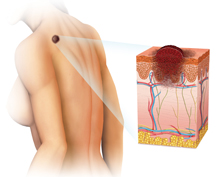 Skin Cancer Diagram
Skin Cancer Diagram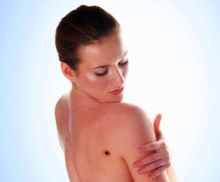 Skin Cancer Photo
Skin Cancer Photo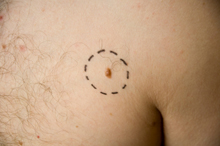 Removal Incision Outline
Removal Incision Outline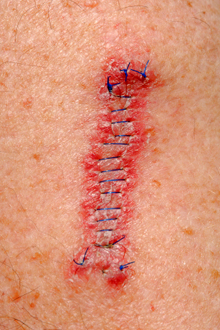 Stitches After Removal
Stitches After Removal
